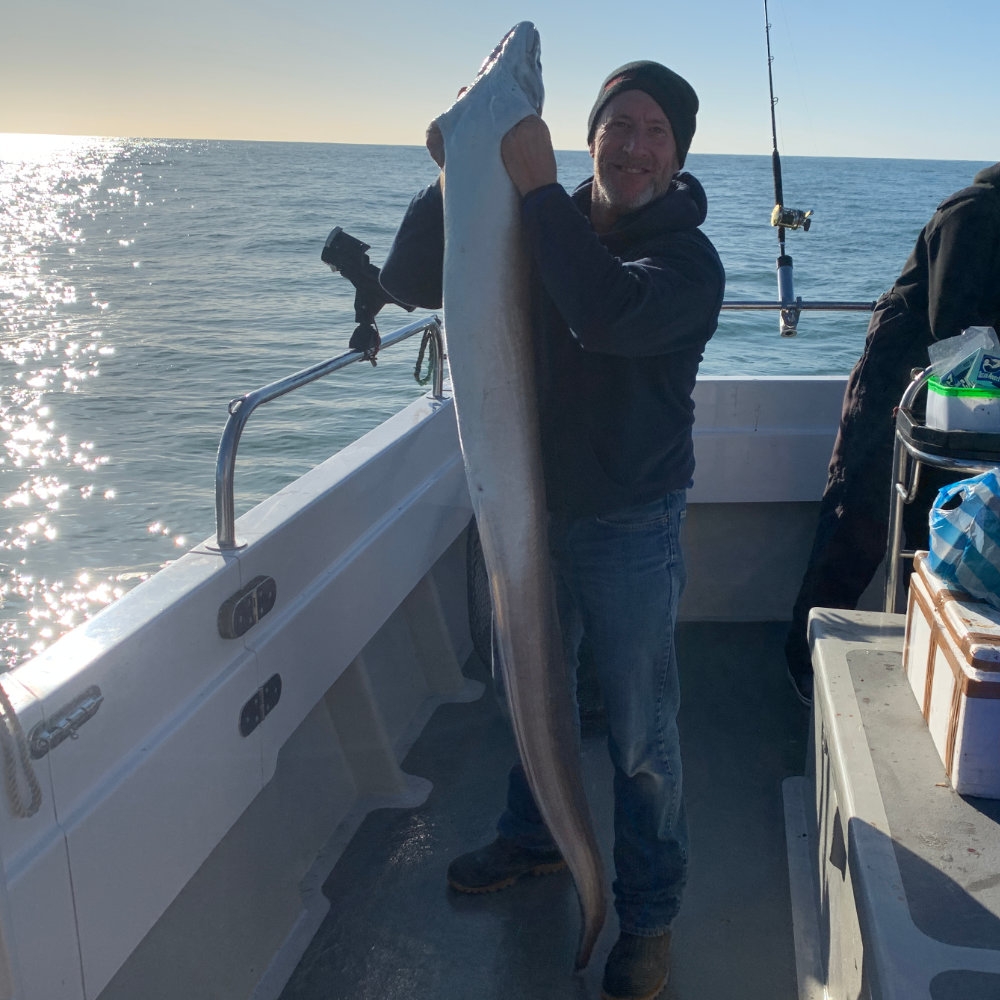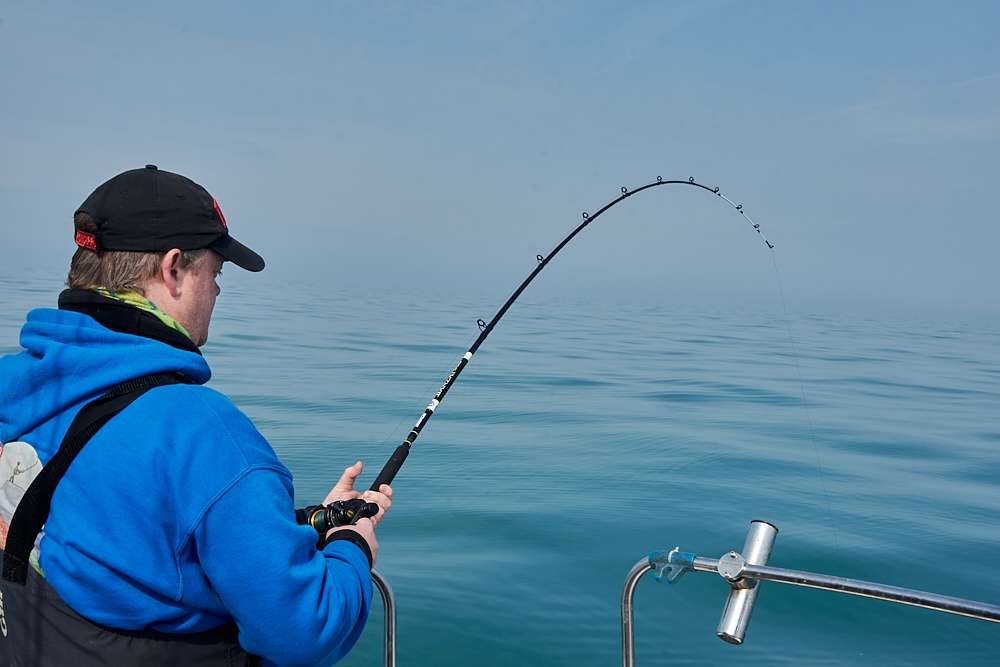Target wreck conger, and it could be a small strap conger of a few pounds or a 100lb monster of the deep. Conger can grow to well over 200lbs and stories of massive conger lost at the boat side abound, so that element of the unknown is always there. Their unique shape and fighting ability make them a worthy adversary.
Wreck Conger Season
You can rightly argue the season lasts all year, but there are periods from February to April and again from September to November that seem to produce the most consistent catches of the bigger fish. The summer period is when the numbers of averaged sized conger are caught, though big fish can show at this time too.

Where Wreck Conger Live
Conger will be resident in all wrecks, but there are differences. Wrecks that have gone down whole in one piece and sit as they would have floated offer less reliable fishing. The eels will be tucked in under the wreck and living in the deck superstructure, but whole wrecks offer fewer hiding holes, and it’s this that restricts their numbers.
If a whole wreck goes down then rolls on its side, this offers a lot more scope for holes and gaps that the conger can get access to, and these can fish very well.
Wrecks that have literally broken their back on the way down, this caused by explosions of ordnance, but also air rushing to the stern and bow, sees the wreck split in two and fall to the seabed in separate sections. The gaping holes of the broken mid-section also spew out a massive amount of debris, which creates a large debris field around the two broken sections. The conger will be in the broken ends of the bow and stern sections, as well as being resident in the debris. These are the wrecks that can produce the very best fishing.
Weather and Tides
Congers respond best to periods of calmer sea conditions with minimal swell, so expect the best fishing to fall a few days after settled weather sets in. The eels will feed in bright daylight, but the best fishing is when overcast skies reduce the light levels entering the water column, and this applies in very deep water too.
In most cases, the smaller neap tides, maybe the middle-sized tides in some areas, with less tidal flow allow the boat to anchor accurately above the wreck and line to be let off to bring the boat just uptide of the wreck. Bigger tides tend to flow too strongly in many areas and with the deep water, often more than 200-feet plus, lead weights more than 2lbs are needed just to reach the bottom. Hence, the smaller tides being the best. Also, the smaller tides see the smaller bait fish more active around the wreck, encouraging the eels to feed.
Congers feed best from low water through the second hour of the flooding tide. Once the tide flow picks up, bites can ease. The 5th hour of the flood when the tide flow starts to ease over some wrecks can also fish well. You’ll also find that the ebb tide can frequently fish better than the flood as the tide flow is a little less, but the skipper will readjust the anchoring position of the boat to get the scent from the baits flowing back into the main part of the wreck or move to a wreck that has fallen so that it faces directly into the oncoming tide.
Tackle for Wreck Conger
Due to the depth and potential size of the fish a heavier rod like the Banzai Boat 20/30lb class is the best option. Match it to a 20/30 class multiplier reel holding 300yds of Tronixpro X8 Probraid in 40/50lbs. Add a mono leader of 75lb Xenon Leader to minimise seabed abrasion on the braid.
- Use a simple sliding ledger rig with a flowing trace. On to the leader slide on a Tronixpro Zip Slider boom followed by a 5mm bead.
- Tie on a size 1/0 Tronixpro SS2 Rolling Swivel or SS2 Ball Bearing Swivel.
- To the rolling swivel, tie on 40-inches (102cms) of 180lb Xenon Leader. A 3 or 4-turn Grinner knot is the best knot for this.
- To the 180lb Xenon Leader tie on a size 8/0 Tronixpro Hooligan hook.

Experiment on the day but adding a Double Rattle Bead about 8-inches above the hook sliding it onto the heavy mono and locking it in place with beads and Tronixpro Rig Gum adds rhythmical noise that congers will come out to investigate. It can add extra fish during some sessions.
Wreck Conger Baits
The common bait is mackerel, either whole as flappers or in halves, depending on the size of the fish. Cut out the backbone and tail from a whole mackerel, leaving the fillets attached to the head. Pass the hook through the mackerel’s jaws for presentation. If you’re missing bites, use a whole small mackerel, and stitch the bait down the length of the bait in and out from the tail towards the head, bringing the hook out just behind the gill cover. This forces the eel to take the head and hook first, resulting in better hook-ups.
If you’re plagued by smaller strap conger up to 20lbs or so, use a whole uncut mackerel. When smaller fish are less prevalent, a half a sizeable mackerel is plenty big enough and releases a lot of scent. Herring works the same way. Fresh pouting is another good bait fished either whole with knife slashes in the flanks to release scent or as a flapper.
Other top conger baits are whole large squid, or two or three normal-sized Calamari squid bound together with bait elastic. Cuttlefish is another great bait fished whole. They’ll also take sections of whiting, coalfish, pollack, cod and pretty much any other species, but the oily fish are the best baits.
Tactics
Big conger are usually reluctant to move far out of the holes inside the wreck. We need to get baits tight to them to induce them out. To do this, judge and change the size of the lead weight you are using so that it just rests on the seabed, but then when you lift the rod tip up a couple of feet and release a few feet of line, the weight will bounce of downtide and come to rest again as the weight hits the seabed. Repeat this until you get bites. What we’re doing is trotting the bait downtide looking to get it to rest within a few feet of the wreck to find the fish. It’s very important to master this method as it is by far the best way to catch congers.
Baits will get washed out quickly, and torn to pieces by small fish, but the scent trail will find the conger and draw them out. Aim to leave your baits down no longer than 20-minutes or so. Fresh baits catch more fish!
A little trick to get a conger to fully commit is to lift the rod tip a few inches to just twitch the bait backwards. This sudden movement can be enough to get a cagey eel to take the bait.
Big conger can be very tentative when feeding. They gently mouth a bait and gradually move it into the mouth before turning away with it and starting to swallow. This process often appears to be small bites from pout and poor cod, but wait! A conger will back off with the bait when it's accepted it. Only when the rod tip pulls over should you lift the rod into its full fighting curve and then literally bully the fish away from the wreck by using short upwards rod pumps and retrieving line as quickly as you can. It is imperative to get the conger away from the snags before it realises it is in trouble. Even when you’ve gained some line, expect a few crash dives back for the wreck. Once in mid-water, just keep the power on and gain line when you can.


